Some of the tracks on these CDs have been previously reviewed by my colleagues on MusicWeb International but the compilations from various sources which we have here appear to be wholly new. However a question mark may arise over the accessibility of these discs, none of which are shown as currently available from Archiv Music although they are listed on Amazon. In one of our reviews in June 2004 (
review) Peter Wells suggested that the collection of recordings he was considering at the time appeared to be “made for the benefit of the composers rather than for any potential listener”. Indeed the compendious nature of several of these discs would seem to confirm that suspicion. Even if that were so, there are plentiful precedents for this.
For many years now we have become accustomed to the direct issue of CDs by performers themselves, either with orchestras and opera houses issuing live or edited performances on their own labels, or more recently soloists recording for labels such as Odradek which distribute profits directly to the performers. There are also precedents in the field of composition. The days are long gone when major record labels would make it a point of honour to record modern composers’ works
en masse as CBS did for Stravinsky or Decca did for Britten. Indeed even in the 1960s there was reluctance on the part of record companies to undertake such projects; John Culshaw notes in his autobiography
Putting the record straight that he had major difficulties with his bosses at Decca who persistently insisted that Britten “would not sell”. More recently, Stockhausen before his death retrieved his DG recordings from the company - who had allowed the discs to go out of circulation - for issue on his own label. After the demise of Collins Classics, Sir Peter Maxwell Davies was obliged to do the same for the many recordings made for that label; Naxos have commendably begun to reissue these. So these Strahan recordings are not something which should necessarily be disregarded. There are some very good things here, which those who are interested in twentieth century music might well wish to track down.
They need hardly concern themselves however with the very long disc
[1] which contains the music Strahan wrote for a series of television documentaries entitled
Shell’s Australia - presumably named after the sponsors. Here it is called
Australian Ark and is the earliest music here
. One does not know the tone adopted by the documentaries themselves but one may surmise that they imitated the slightly ‘humorous’ style of Walt Disney’s wildlife programmes of the 1950s and 1960s. This was before David Attenborough came along with
Life on Earth and showed everybody how it really should be done. The music is occasionally jazzy, occasionally sinister, but relentlessly short-breathed and trivial. The theme tune for the series comes around regularly in different guises which totally fail to mask its insistent perkiness. The music may have been tolerable in connection with the original visual images, but I cannot imagine that the smarmy Hammond organ which makes the Great Barrier Reef sound like a cheap and sleazy nightclub would have been acceptable under any circumstances at all. The players in the ensemble vary from one series to the next, but they are all terribly close to the microphone in an airless studio acoustic. They sound understandably bored, with a fair smattering of what are surely wrong notes. Those who persistently write to the BBC complaining about the use of background music in Attenborough’s documentaries should hear this effort!
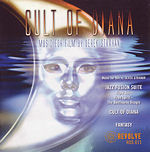
The second disc
[2] contains three more film scores, this time for cinematic
releases, in the shape of the
Jazz Fusion Suite from the as
yet unmade
Big Girl Band although selections were subsequently
used in the film
Leonora. We also get suites from
Cult
of Diana and
Fantasy. I must say that the
Jazz Fusion
Suite hardly seems to reflect the idea of a film musical based
on a big band, being indeed rather pop-orientated. It would not I imagine
find producers reaching for their cheque books. The booklet tells us
that the opening movement “evokes the biblical account of events leading
to the Apocalypse” – although what that has to do with the original
film scenario is far from clear. The use of special electronic effects
at the end adds little. The second movement
Free spirit is
a slow rock ballad, and although we are told the final
Beethoven
boogie is intended as a satire on ‘switched-on classics’ it comes
over as all too much like the pop arrangements satirised even if it
is clearly not meant to be taken seriously.
The music for
Cult of Diana is far less obviously pop-orientated, using a live flute and saxophone in combination with an otherwise synthesised score. Similarly the score for
Fantasy is entirely synthesised – in his booklet note Strahan notes that the production was made on a “modest budget.” The track-listing notes enigmatically that
Jenny’s theme is played twice, once on “strings” and once on “horns”. Although the synthesiser makes a good fist of the imitation horns, the strings sound very artificial indeed. The track
Strange house contains a reference to Siegfried’s Funeral March which is unexplained. The suite ends inconclusively and abruptly.
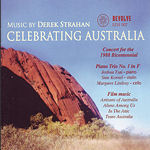
More
scores for film documentaries are found on the third CD
[3] containing
music for
Aliens among us,
Artisans of Australia and
the
Trans Australia Suite from the film
Wheels across Australia.
Extraordinarily enough the booklet confesses that the names of the trumpeter
and trombonist in the last are not known, although all the other soloists
are individually identified.
Artisans of Australia begins with
a piano solo playing a near-clone of
Auld lang syne which Strahan
hopefully describes as an “original theme of Irish character”. This
is then used as the basis for a series of short variations for various
instruments: recorder, bassoon, and so on, ending with a ‘mini-suite’.
By this time the theme seems to have transmogrified into
Swansea
Town. This is thoroughly attractive music, if only on occasion
noticeably original.
Aliens among us derives from two film documentaries entitled
Aliens among us and
Garden jungle. The music here also begins as a set of variations on a perky tune first played on the harpsichord, but the music for
Garden jungle is rather more predatory in tone. The
Trans Australia Suite is also highly personable with a jolly theme tune running through. Oddly the solo horn theme which is clearly identified as
Waltzing Matilda is quite well disguised – presumably to allow for its counterpoint with the main theme which occurs during the penultimate track. There are some very beautiful items here, although all of the fifteen tracks are very short with only three cues lasting more than two minutes.
This disc also contains two pieces of chamber music written for concert performance – the
Piano Trio and the very short neo-classical suite
In the attic. The
Piano Trio was written to commemorate the Australian Bicentennial. It is a predominantly light-hearted piece with some jazz overtones evident which are then developed in a more conscientiously classical style. The finale entitled
Pursuit of happiness is indeed a very happy rondo in 6/8 time, almost ‘palm court’ music which could have been written at any time in the previous century. The playing is jolly and responsive.
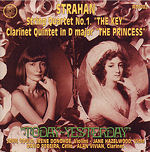
The fourth CD
[4]
offers us a coupling of two other chamber works: a string quartet subtitled
The Key and a clarinet quintet subtitled
The Princess.
The first is the result of a love affair between the composer and Lorna
Key, whose first name is transposed into a musical cipher (La-Octave-Re-Ninth-A).
Like Berlioz before him, Strahan takes this cipher as an
idée fixe
which recurs throughout all four movements of the quartet, which run
continuously. The opening movement is fiercely Bartókian in idiom, with
the
idée fixe given “settings of increasing rhythmic heat”,
but the slow movement is something quite different. A review in
The
Australian in 1981 when this recording was first issued described
this movement as “extraordinarily beautiful” and quite justifiably so.
The music owes much to the romantic tradition, with turns of phrase
that remind the listener of the sextet from Strauss’s
Capriccio,
itself a portrait of an idealised lady with whom the composer is more
than half in love. The work is linked in turn to the clarinet quintet,
a depiction in music of Beethoven’s patroness Countess Lichnowsky, to
whom Lorna Key bears a striking physical resemblance - as the pictures
of both on the booklet cover bear witness. The clarinet quintet is in
classical form with the usual four movements. The music is decidedly
twentieth century, with some jazz influences entering into the clarinet
part. It is more light-hearted than
The Key, but remains a
serious work nonetheless, and there are some superbly melodic phrases
which constantly catch the attention. The players in both these performances
are not apparently a regular chamber music ensemble, but were specifically
recruited by the composer for the recording; you would never tell from
their responsive and alert playing that they had not been together for
years. This particular disc will repay further investigation by listeners.
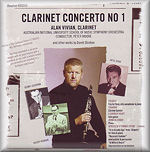
The clarinet returns
in the
Clarinet Concerto featured on another disc
[5].
This begins rather forbiddingly with a movement called
Urban angst
but the slow ballad-like second movement and the jazzy finale are much
more approachable, with decided overtones of Aaron Copland. This is
the largest-scale performance on any of these discs, and the playing
of Alan Vivian and the student orchestra are excellent. The player of
the marimba, who almost assumes co-solo status in the first movement,
should really have been credited.
This disc is completed by a number of shorter works, or extracts from longer ones. The trio
Escorts is described as an ‘opera without words’ and tells in highly compressed form of a quarrel and reconciliation between the composer and his girlfriend. Actually I would have thought that a staged drama without words would normally be described as a ballet, but Strahan clearly considers the piece to be a concert work. Since it only lasts twelve minutes (in five ‘acts’!) it would also be one of the shortest operas on record, surpassing even Milhaud’s
operas-minutes. It is quite a modern-sounding piece, especially in the quarrel scenes - there are jazz elements and a Beethoven quote elsewhere - but the music is not done any favours by an extremely close-microphoned recording that has the three instrumentalists practically in your ear.
This is followed by ‘excerpts’ from the ‘dance suite’
Fashions for clarinet and string quartet, a set of variations lasting a mere three minutes; a guitar arrangement of the theme from the documentary
A sawdust heart originally scored for circus band and recorded at the composer’s “Bondi Beach pad”; and a performance by the composer on ‘virtual piano’ (presumably a synthesiser) of an
Ironical Rondo another rather jazzy piece written originally when Strahan was a schoolboy in Belfast but including some ‘recent additions’. All these are performed with hardly a break between tracks, which produces some sudden and surprising jolts.
Back in April 2004 Christopher Howell reviewed Strahan’s
Atlantis for flute and piano, not very favourably (
review); but he did think the movement
Et in Arcadia ego was the best thing in it. We are here given a performance of this single movement taken from the same recording. The close microphone placement shows off the flautist’s breathing rather obviously. The performance of the movement
Mesozoic Summer from
The Australian Ark is also the same as that on the CD of the complete music reviewed above. These two brief extracts are included purely to show Strahan’s ‘genesis of a theme for summer’ which also forms the basis for the ‘improvisation on a theme for summer’
At Milford Beach, played here by the composer on pedal harmonium. This is very much a ‘home-made’ recording, with the background sound of surf on the beach very much in the foreground and seagulls faded in at the beginning and end. It’s nicely laid-back, but it’s a pretty private sort of document.
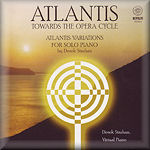
The
Atlantis
Variations, on the other hand, are a very public statement
[6].
The Atlantis mystery has, at least to my satisfaction, been largely
solved in recent years by archaeological discoveries in Santorini and
Crete. If one accepts that Plato misunderstood what he was told by Egyptian
priests and that the date of the Atlantis civilisation was 900 years
before and not 9,000, then most of the description of Atlantis he gives
us matches with remarkable accuracy with the trading settlement on the
island of Thera (now Santorini) which exploded in a titanic volcanic
eruption at around that date, destroying the highly technical culture
not only on that island but also on its colony settlements on Crete
– what has long been known as the Minoan civilisation. This also coincidentally
links in with the contemporary abandonment of tin mining as far away
as Cornwall - it did not revive until Roman times - as presumably the
market for bronze would have dried up at the same time. All these fascinating
discoveries, which are still unfolding, clearly supersede the realms
of fantasy and romance which have been woven about the Atlantis myth
since time immemorial.
Strahan is proposing to write an operatic tetralogy on this subject. It is not clear what narrative he intends to employ for this, but the hints that are given are not encouraging. He will have no truck with any of the above. Instead, in an essay entitled “Historical basis for the program”, he adopts the highly tendentious thesis of Otto Heinrich Muck - based in turn on speculatively reconstructed Mayan records. This links the downfall of Atlantis to an asteroid impact – itself highly speculative and lacking any archaeological or geological evidence – dated to 8498 BC. This is also proposed as a theory to explain the extinction of the Pleistocene megafauna such as the mammoth. One has an uneasy feeling that early human predators may have had more to do with the mass extinction. Then, last year we discovered that the Mayans couldn’t even get the end of the world right.
From the musical point of view, however, all of this is not important. We do not dismiss mythological works such as Wagner’s
Ring because there is no historical evidence for the existence of the Norse gods. Instead we regard them as symbols which serve to illustrate archetypical truths. However in the
Atlantis Variations, the largest-scale work from the ‘
Atlantis cycle’ contained on these CDs, the programme follows the Muck hypothesis in considerable detail. The first seven variations take various aspects of the astronomical theory as the basis for individual movements, which indeed are distinct tone-pictures in their own right rather than variations on any one theme. It is only in the third part, consisting of the final four movements of the ‘variations’, that the destruction of Atlantis itself is portrayed. At this point it might be helpful to observe that I myself have composed a piano rondo
Akallabêth based on Tolkien’s version of the Atlantis myth, and find that not surprisingly there are considerable points of similarity in the writing for the instrument. These are purely coincidental: my work was written some years before Strahan’s, although it was not published until after his piece was written. On that basis of reasoning alone I must therefore declare without any possible qualification that Strahan’s response to the mythological material is entirely appropriate and engaging! Strahan’s piece is considerably longer than mine, but did not seem over-extended and I thoroughly enjoyed it.
These
Atlantis Variations, although they are reviewed in some detail in Larry Sitsky’s book
Australian piano music of the twentieth century published in 2005, have never actually been publicly performed. This is perhaps not so surprising when one considers the extreme technical difficulty of the piano writing, which bids fair to rival that of Sorabji in its complexity. What we are given here is a recording on synthesiser made by the composer. Strahan spends some considerable time justifying this use of modern computer technology. He does not mention Sibelius in his booklet notes, but the recording details disclose that Sibelius software was indeed used. He rightly emphasises the need to be extremely precise in the preparation of the score for recording – what I call ‘rehearsing’ the computer. In fact the piano sound that Sibelius produces is remarkably realistic, enabling passages of considerable technical complexity to be clearly enunciated. Perhaps
too clearly enunciated for a truly realistic effect: the sound is rather like a slightly too closely microphoned piano, and the Sibelius software can produce a more distanced effect to advantage. There is a real problem with the matter of piano pedalling; the most precise ‘rehearsal’ of the computer cannot really reproduce the subtle effects of the use of the sustaining pedal. Arpeggios in particular can sound too precise and clinical.
We are told in the booklet which accompanies the string quartet and clarinet quintet that when he was studying in the UK Strahan was given “little encouragement … to develop his interest in music, composition and theatre.” That was a shame, as we might have lost a compositional talent - if not a genius. We are also told that he began his career in Australia as a television scriptwriter, hence presumably his movement into writing music for television documentaries. It must be observed however that after the
Trans Australia Suite his style shows a remarkable degree of diversity and influences ranging from folk music through jazz to Copland and finally the realms of cheap nightclub music. There is no apparently settled idiom, indeed sometimes a bewildering variety of them in close proximity to each other. However other of these discs should have a far wider circulation. I would in particular commend the
Atlantis Variations which is a major work where Strahan really begins to let us hear his own compositional voice.
Paul Corfield Godfrey
